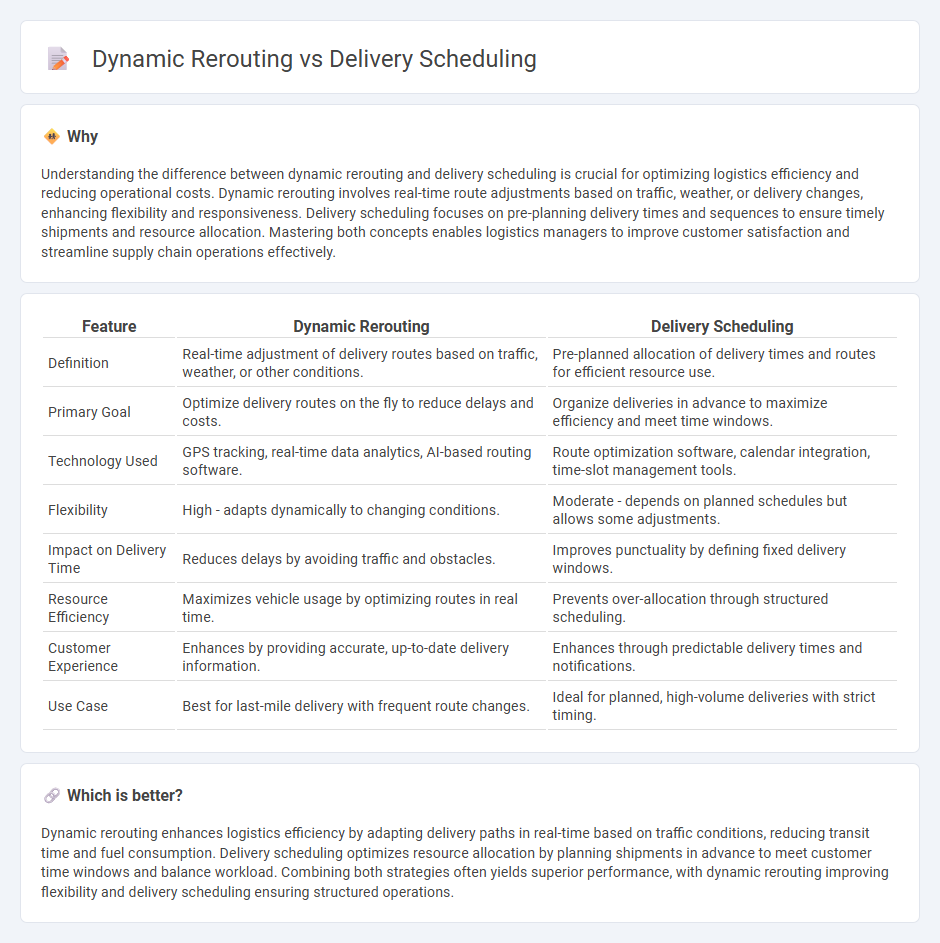
Dynamic rerouting enhances logistics efficiency by allowing real-time adjustments to delivery routes based on traffic, weather, and other unexpected factors, reducing delays and fuel consumption. Delivery scheduling focuses on pre-planning optimal time slots for shipments to ensure timely arrivals and resource allocation. Explore how integrating dynamic rerouting and delivery scheduling can transform supply chain performance.
Why it is important
Understanding the difference between dynamic rerouting and delivery scheduling is crucial for optimizing logistics efficiency and reducing operational costs. Dynamic rerouting involves real-time route adjustments based on traffic, weather, or delivery changes, enhancing flexibility and responsiveness. Delivery scheduling focuses on pre-planning delivery times and sequences to ensure timely shipments and resource allocation. Mastering both concepts enables logistics managers to improve customer satisfaction and streamline supply chain operations effectively.
Comparison Table
| Feature | Dynamic Rerouting | Delivery Scheduling |
|---|---|---|
| Definition | Real-time adjustment of delivery routes based on traffic, weather, or other conditions. | Pre-planned allocation of delivery times and routes for efficient resource use. |
| Primary Goal | Optimize delivery routes on the fly to reduce delays and costs. | Organize deliveries in advance to maximize efficiency and meet time windows. |
| Technology Used | GPS tracking, real-time data analytics, AI-based routing software. | Route optimization software, calendar integration, time-slot management tools. |
| Flexibility | High - adapts dynamically to changing conditions. | Moderate - depends on planned schedules but allows some adjustments. |
| Impact on Delivery Time | Reduces delays by avoiding traffic and obstacles. | Improves punctuality by defining fixed delivery windows. |
| Resource Efficiency | Maximizes vehicle usage by optimizing routes in real time. | Prevents over-allocation through structured scheduling. |
| Customer Experience | Enhances by providing accurate, up-to-date delivery information. | Enhances through predictable delivery times and notifications. |
| Use Case | Best for last-mile delivery with frequent route changes. | Ideal for planned, high-volume deliveries with strict timing. |
Which is better?
Dynamic rerouting enhances logistics efficiency by adapting delivery paths in real-time based on traffic conditions, reducing transit time and fuel consumption. Delivery scheduling optimizes resource allocation by planning shipments in advance to meet customer time windows and balance workload. Combining both strategies often yields superior performance, with dynamic rerouting improving flexibility and delivery scheduling ensuring structured operations.
Connection
Dynamic rerouting and delivery scheduling are interconnected through real-time data integration that optimizes transportation routes and delivery times to enhance efficiency and reduce costs. Advanced algorithms analyze traffic patterns, weather conditions, and delivery priorities to continuously update schedules and reroute vehicles, ensuring timely arrivals and resource optimization. This synergy improves customer satisfaction by minimizing delays and adapting swiftly to unexpected disruptions in the logistics network.
Key Terms
**Delivery Scheduling:**
Delivery scheduling optimizes the allocation of time slots and resources to ensure timely and efficient order fulfillment, reducing wait times and improving customer satisfaction. Advanced scheduling systems leverage predictive analytics and real-time data to balance demand and capacity, maximizing route efficiency and minimizing operational costs. Explore deeper insights into delivery scheduling strategies and their impact on logistics performance.
Time Windows
Delivery scheduling ensures shipments adhere to predefined time windows, optimizing customer satisfaction by aligning deliveries with specific time slots. Dynamic rerouting adjusts routes in real-time based on factors like traffic or delays, aiming to maintain timely arrivals within those time windows. Discover how integrating both approaches can enhance on-time delivery performance and operational efficiency.
Route Planning
Delivery scheduling establishes fixed time windows and sequence for deliveries, optimizing resource allocation and customer satisfaction. Dynamic rerouting adjusts routes in real-time based on traffic, delays, or urgent orders, enhancing efficiency and reducing delivery times. Explore how integrating both strategies can revolutionize your route planning and logistics management.
Source and External Links
What is Delivery Scheduling? Key Importance & Best Practices - Delivery scheduling is the process of planning and organizing product deliveries to ensure timely and efficient customer fulfillment; key best practices include prioritizing customer communication, optimizing route planning, implementing real-time tracking, using data analytics, maintaining flexibility, training drivers, and regularly reviewing performance.
5 Tips for Scheduling Deliveries Efficiently + Free PDF Guide - Effective delivery scheduling involves defining clear delivery objectives, collecting and analyzing delivery data, and choosing appropriate scheduling and route optimization software to maximize efficiency, reduce costs, and improve customer satisfaction.
A Guide To Better Delivery Scheduling - Transvirtual - Delivery scheduling is the process that determines order delivery routes and sequences, supported by clear inventory visibility, route optimization to minimize travel distance between stops, and organizing delivery stops into efficient trips for drivers.
 dowidth.com
dowidth.com